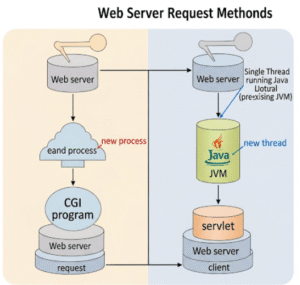Introduction to Servlets: A Server-Side Revolution
Hello everyone! In web development, understanding how servers process client requests is fundamental. This brings us to the Introduction to Servlets, which are robust Java programs designed to extend the capabilities of web servers. Essentially, Servlets act as powerful intermediaries that accept requests from web clients, perform specific tasks on the server, and then return dynamic results to the client’s web browser.
What Exactly are Servlets?
A Servlet is a Java program that extends the capabilities of a web server. It’s executed by the web server and serves as a server-side component for processing requests from clients, typically web browsers. Think of a Servlet as a server-side applet; it accepts a request from a client, performs some logic (like interacting with a database or generating dynamic content), and then sends a response back to the client, often in the form of HTML pages.
Servlets operate within a web server’s environment. When a client sends an HTTP request, the web server forwards it to the appropriate Servlet. The Servlet then processes this request, executes the required server-side logic, and constructs an HTTP response, which is then sent back through the web server to the client. This entire interaction happens seamlessly, allowing for highly interactive and dynamic web applications.
Servlets and the Common Gateway Interface (CGI): A Comparison
Before Servlets gained prominence, the Common Gateway Interface (CGI) was a widely used standard for generating dynamic web content. CGI programs, often written in languages like Perl, C, or shell scripts, would execute as separate processes on the server for each client request. However, this approach presented several significant drawbacks, which Servlets were designed to overcome.
Why Servlets Surpassed CGI
Servlets offer distinct advantages over traditional CGI programs, leading to their widespread adoption for server-side processing:
- Efficiency: Every time a client requested a CGI program, the web server had to create a new process to run that program. This process creation was resource-intensive and slow. Conversely, Servlets run within the web server’s existing Java Virtual Machine (JVM). A new thread, rather than a new process, handles each request, making them far more efficient and scalable.
- Performance: Since Servlets operate in the same process as the web server (or within a Servlet container), there’s less overhead compared to CGI. This results in significantly faster response times, especially under heavy load.
- Robustness: If a CGI program crashes, it can potentially affect the entire web server. However, Servlets are managed by a Servlet container (like Apache Tomcat). The container provides a more controlled environment, isolating Servlets from each other and the server, thereby enhancing the overall robustness of the application.
- Platform Independence: As Servlets are written in Java, they inherently inherit Java’s “write once, run anywhere” philosophy. This means a Servlet developed on one operating system can run on any other system that supports Java and a Servlet container, unlike CGI programs that might be platform-specific.
- Extensibility: Servlets can directly access all Java APIs, including JDBC for database connectivity, RMI, and more. This broad access to the powerful Java ecosystem makes Servlets highly extensible and capable of performing complex server-side tasks.

Basic Requirements for Servlet Development
To develop and run Servlets effectively, certain software components are essential:
- Java Development Kit (JDK): This provides the Java compiler (
javac) and the Java Runtime Environment (JRE) necessary to compile and run Java applications, including Servlets. - Java Servlet Development Kit (JSDK) / Servlet API: While the JSDK used to be a standalone component, its functionalities are now typically bundled within Servlet containers. The core need is the Servlet API (specifically the
javax.servletandjavax.servlet.httppackages), which provides the interfaces and classes required to write Servlets. - A Web Server with a Servlet Container: This is crucial. A web server (like Apache HTTP Server) serves static content, but for Servlets, you need a Servlet container (also known as a web container). Popular examples include Apache Tomcat, GlassFish, or Jetty. The container manages the lifecycle of Servlets, maps URLs to Servlets, and handles HTTP requests and responses.
- A Client Application: Typically, this is a web browser (like Chrome, Firefox, Edge) that sends HTTP requests to the web server and displays the responses from the Servlets.
The Servlet API: Foundation for Server-Side Java
The Servlet API is a collection of Java classes and interfaces that allow developers to create Servlets. It is primarily contained in two packages:
javax.servlet: This package provides generic, protocol-independent Servlet interfaces and classes. The most fundamental interface here isServlet.javax.servlet.http: This package extends the generic Servlet capabilities to handle HTTP-specific requests and responses. Key interfaces and classes includeHttpServlet,HttpServletRequest, andHttpServletResponse.
By extending HttpServlet (which implements the Servlet interface and provides methods for handling HTTP requests like doGet() and doPost()), developers gain access to a powerful set of tools to process web requests and generate dynamic content.
In conclusion, the introduction to Servlets marks a significant step in web development. They provide a robust, efficient, and platform-independent solution for handling dynamic server-side logic, fundamentally improving upon earlier technologies like CGI. Understanding their core principles and the Servlet API is crucial for anyone building modern web applications in Java.
